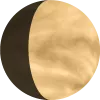Planets Visible in the Sky Tonight
Sky Map
Celectial bearing and elevation at 15:59
The planets of our Solar System travel around the Sun at different speeds, which creates distinctive patterns of visibility from Earth. Each planet moves along its own orbit, taking a different amount of time to complete a full circle around the Sun. These variations in orbital period, combined with the relative positions of Earth and the other planets, determine when a planet is visible in the sky, how long it can be seen, and where it appears on the horizon.
Planets Visible Tonight
Discover the planets that are currently visible in the night sky. Learn about their positions, rise and set times, and how to spot them from your location. Whether you’re a seasoned astronomer or just starting out, this guide will help you make the most of your stargazing experience.
Planets that are currently not observable
Here, we provide information on planets that are currently not visible from Earth. Learn about their positions, and when they are expected to become observable again.
Venus
Rises at sunrise
Venus is currently in the constellation Sagittarius. It is currently in conjunction with the Sun and not observable, but will reach its next greatest elongation on 2026-08-16.
Mars
Rises at sunrise
Mars is currently in the constellation Sagittarius. It is currently in conjunction with the Sun and not observable, but will reach its next opposition on 2027-02-21.
Pluto
Visible from sunset through most of the night
Pluto is currently in the constellation Capricornus. It is now fading as it moves toward conjunction, and will reach its next opposition on 2026-07-28.
Upcoming Planetary Events
Discover the most captivating planetary events coming soon, including oppositions, elongations, retrograde motions, and close approaches. These phenomena showcase the intricate movements of planets in our solar system:
- Oppositions and Greatest Elongations: During opposition, a planet is directly opposite the Sun, shining at its brightest and visible all night. At greatest elongation, a planet reaches its farthest angular distance from the Sun, offering optimal viewing conditions.
- Retrograde Motions: Witness the optical illusion of a planet moving backward in the sky, caused by the relative motion of Earth and the planet.
- Close Approaches: During close approaches, planets appear to come exceptionally close to one another in the sky, even though they remain separated by vast distances in space. During these events, the planets may appear so close together that they resemble double stars.
Keep track of these events and enjoy the beauty of the ever-changing heavens!
| Time | Description | Constellation |
|---|---|---|
| Fri, 26 December 2025, 17:33 | Close approach of Saturn and the Moon. Distance - 4°, position - 40° above the horizon at Southeast | Pisces |
| Mon, 5 January 2026, 02:02 | Close approach of Jupiter and the Moon. Distance - 3°, position - 44° above the horizon at East | Cancer |
| Tue, 6 January 2026, 14:00 | Sagittarius | |
| Fri, 9 January 2026, 14:00 | Sagittarius | |
| Sat, 10 January 2026 | Jupiter is in Opposition | Gemini |
| Thu, 22 January 2026, 14:00 | Capricornus | |
| Fri, 23 January 2026, 14:00 | Capricornus | |
| Tue, 3 February 2026 | Retrograde motion of Uranus ends | Taurus |
| Fri, 20 February 2026 | Greatest Elongation of Mercury | Pisces |
| Wed, 25 February 2026 | Retrograde motion of Mercury begins | Pisces |








